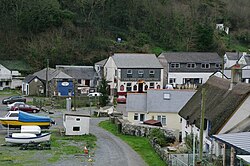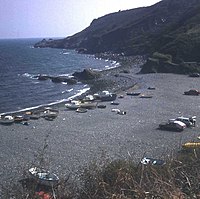Porthallow: Difference between revisions
Created page with "{{Infobox town |name=Porthallow |county=Cornwall |picture=Porth pic.jpg |picture caption=Porthallow |os grid ref=SW796233 |latitude=50.069 |longitude=-5.081 |population= |cen..." |
mNo edit summary |
||
| Line 13: | Line 13: | ||
|dialling code=01326 | |dialling code=01326 | ||
|LG district=Cornwall | |LG district=Cornwall | ||
|constituency= | |constituency=St Ives | ||
}} | }} | ||
'''Porthallow''' is a small fishing village on the east coast of [[the Lizard]] peninsula to the south of the [[Helford River]], in [[Cornwall]]. It sits between the two neighbouring villages of [[St Keverne]] and [[Roskorwell]]. | '''Porthallow''' is a small fishing village on the east coast of [[the Lizard]] peninsula to the south of the [[Helford River]], in [[Cornwall]]. It sits between the two neighbouring villages of [[St Keverne]] and [[Roskorwell]]. | ||
Latest revision as of 18:58, 23 September 2016
| Porthallow | |
| Cornwall | |
|---|---|
 Porthallow | |
| Location | |
| Grid reference: | SW796233 |
| Location: | 50°4’8"N, 5°4’52"W |
| Data | |
| Post town: | Helston |
| Postcode: | TR12 |
| Dialling code: | 01326 |
| Local Government | |
| Council: | Cornwall |
| Parliamentary constituency: |
St Ives |
Porthallow is a small fishing village on the east coast of the Lizard peninsula to the south of the Helford River, in Cornwall. It sits between the two neighbouring villages of St Keverne and Roskorwell.
One road runs through the village, and there is a post office and public house, The Five Pilchards (named for the local pilchard fishery). The South West Coast Path passes through the village.
Porthallow is within the 'Cornwall Area of Outstanding Natural Beauty', as is almost a third of the county.[1]
Geography
Porthallow is on the east coast of the Lizard peninsula, an area known for its natural history, especially geology and plants. Along the coast, to the north, is Gillan Creek and the Helford River, and to the south is the village of Porthoustock. Offshore lie The Manacles, a great hazard to shipping and consequently a popular diving site for shipwrecks.
The beach is privately owned with access open to all and consists of pebbles at the higher reaches and sand at low tide. Once a pilchard fishery was carried on tfrom this beach.
Geology
The geology of the Lizard is complex and of great interest to geologists. The peninsula can be divided into two areas, with an irregular boundary running between Polurrian Cove on the west (Mount's Bay) coast and Porthallow in the east. To the north is the Meneage and to the south the Lizard, with the geology differing greatly between the two districts. The coast to the north of the village is designated as a Geological Conservation Review site, and to the north and south is designated as a 'Site of Special Scientific Interest'.[2][3]
Some 270 million years ago when the Lizard rocks were thrust up, the Meneage Crush Zone and Meneage Breccia was formed and the rocks to the north are of thick beds of conglomerates, and a combination of clay slates, mixed with sandstones and grits containing veins of quartz. To the south the rocks are serpentine, gabbro and hornblende schist.[4]

History
Porthallow, meaning “port at the end of the moor”, was a flourishing fishing village in the 13th-century. It was first used as a fishing base by Beaulieu Abbey. Rents raised on fishing ports within the Duchy of Cornwall, during the 14th-century, indicate that Porthallow was a major fishing village paying slightly less rent than Fowey to the east.[5]
In 1836, The West Briton newspaper reported that several ″seans″ operated on the Lizard Peninsula at Perhala (Porthallow), Proustock (Porthoustock), The Lizard (possibly Polpeor Cove), and others – a fishing method using hand-drawn nets to catch pilchards. Some pilchards were taken to Falmouth and sold for two shilling per hundred, the rest would feed local people during the winter.[6]
The Trelowarren estate later owned the village and leased it to The Porthallow Pilchard Curing Company from 1914 to 1937. It was then bought by the Porthallow Institute and Reading Room.
In the 1960s the village was popular as a launch site for diving on the Manacles with a compressor and dive shop on the beach. Diving activities were banned from the beach following years of late night parties, loud music and bonfires, when in 1971, Trustees from the village bought and ran the beach. The Porthallow Village Association became a charity in 2008 and is now still maintained by a voluntary group of Trustees from the village. There is a Diving Centre at Polkerris, half a mile to the south.[7]
A new village hall was built in 2010.[5]
Outside links
| ("Wikimedia Commons" has material about Porthallow) |
- Porthhallow, Cornwall; Explore Britain
References
- ↑ Porthallow.com
- ↑ Little Dennis - Gillian Harbour - Nare Head - Porthallow (Marine Devonian) - Joint Nature Conservation Committee
- ↑ SSSI listing and designation for Meneage Coastal Section
- ↑ Lawman, Jean (1994). A Natural History of the Lizard Peninsula. Redruth: Institute of Cornish Studies and Dyllansow Truran. pp. 120. ISBN 1 85022 071 9.
- ↑ 5.0 5.1 Porthallow Village Association
- ↑ "Pilchard Fishery". West Briton. 30 September 1836.
- ↑ Larn, Richard (1996). Dive South cornwall (3rd ed.). Teddington: Underwater World Publications Ltd. ISBN 0 946020 25 6.
